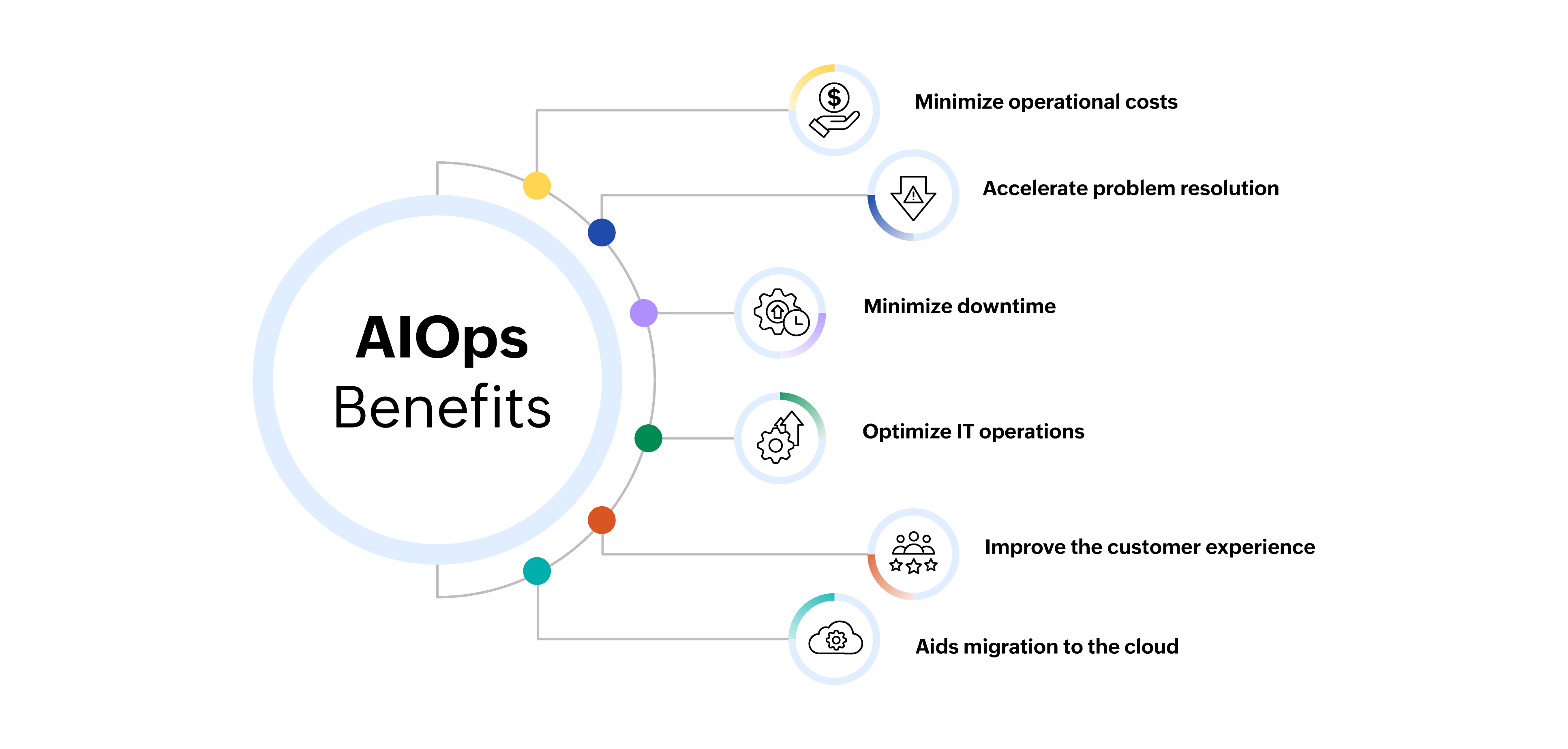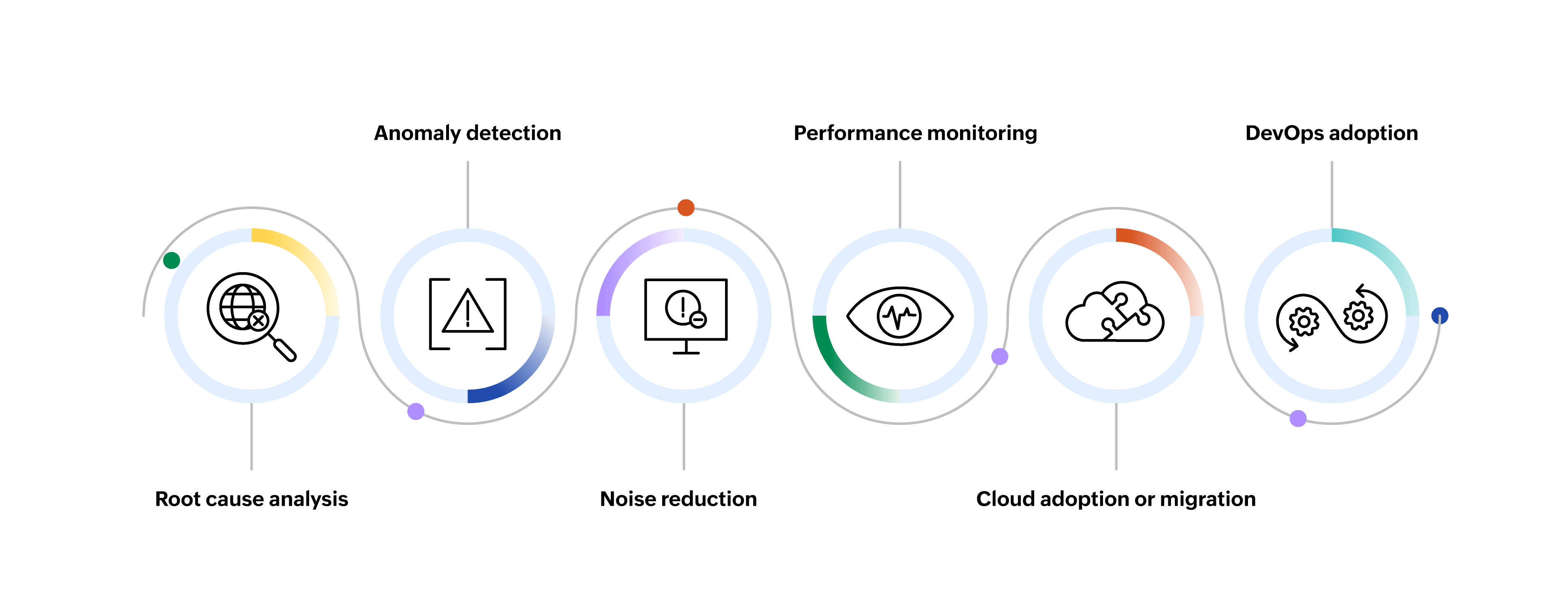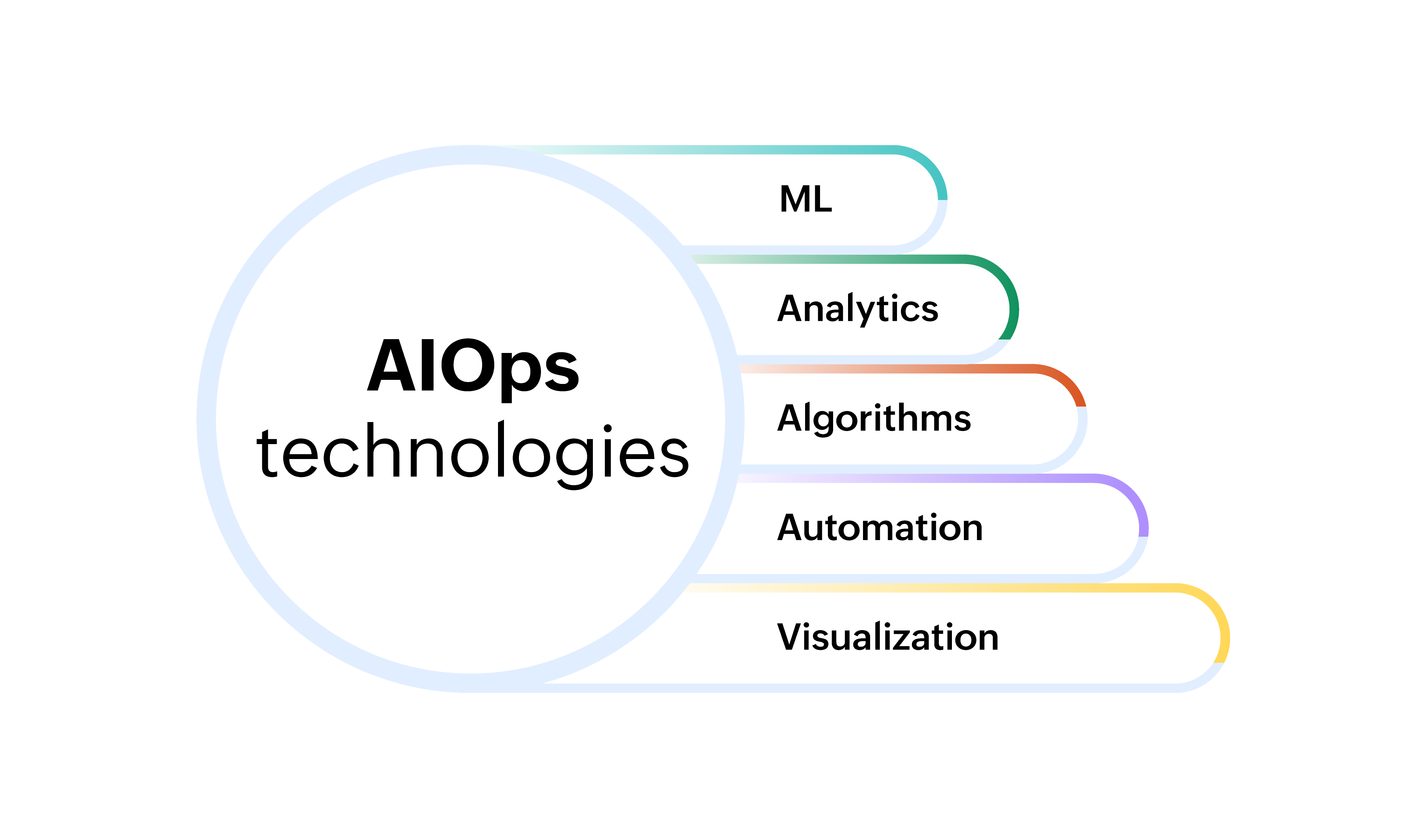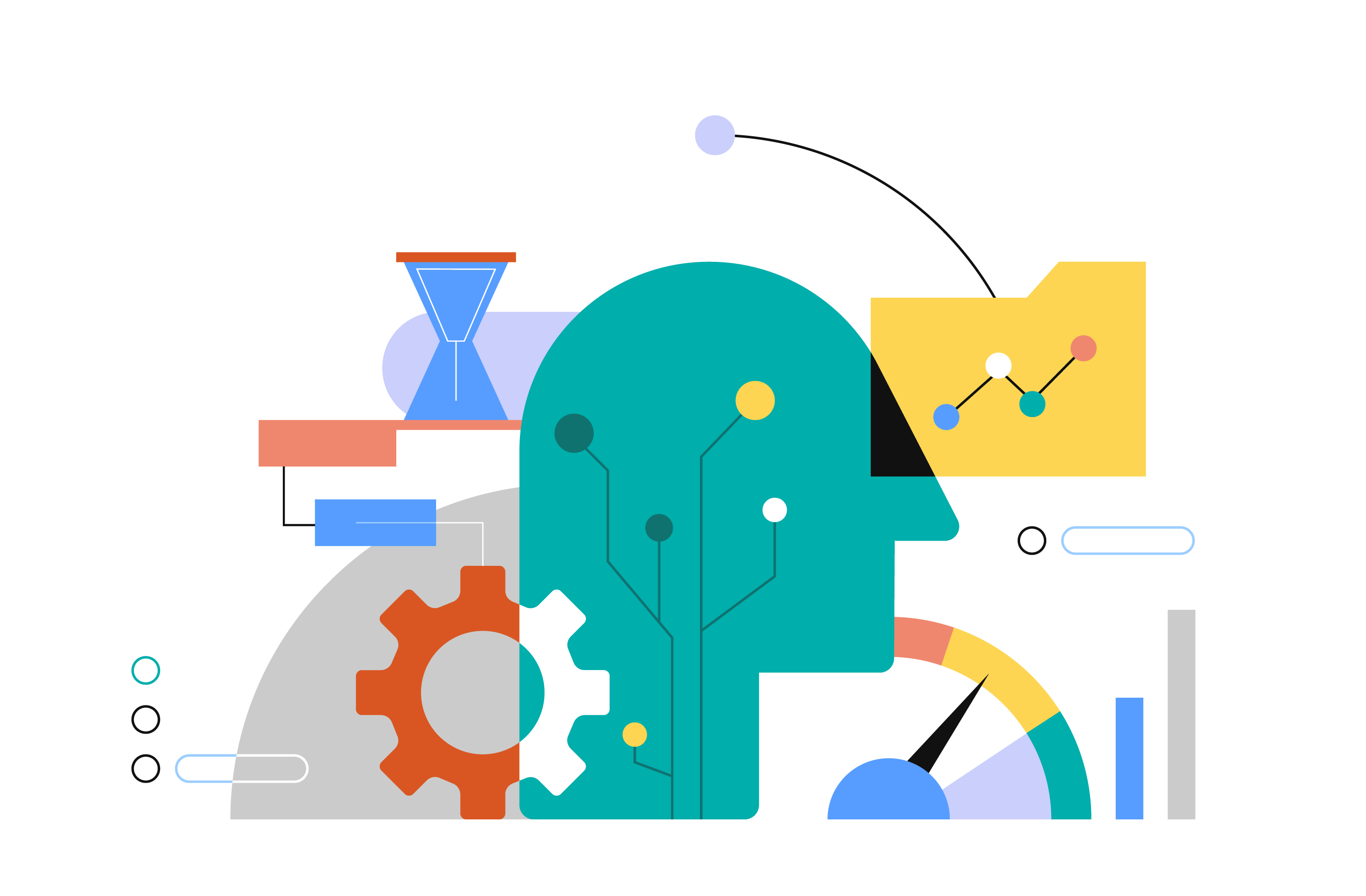What is AIOps?
AI for IT Operations, or AIOps, is the use of ML and AI approaches to improve and automate IT operations workflows. It involves using data analysis, algorithms, and automation to improve the speed, accuracy, and efficiency of IT operations, including monitoring, event correlation, and incident management.
AIOps can help organizations proactively identify and resolve IT issues, reduce downtime, and improve overall system performance. It can also assist in predicting and preventing future problems by analyzing historical data and patterns. AIOps is often used in conjunction with DevOps practices to optimize the entire IT operations life cycle.
What are the types of AIOps solutions?
AIOps offers a powerful toolbox for optimizing operations and reducing costs. Here's a quick look at the two main approaches:
- Domain-centric AIOps: These AI-powered tools tackle specific areas like network or application performance, providing in-depth monitoring and troubleshooting for operational teams.
- Domain-agnostic AIOps: These solutions gather data across your entire IT infrastructure, regardless of domain. They leverage a holistic view for advanced features like predictive analytics and AI automation, driving proactive problem-solving and improved efficiency.
Choosing the right AIOps solution depends on your specific needs. By understanding their strengths, you can empower your IT teams and set them up for success.
Benefits of AIOps
Incorporating, analyzing, and utilizing ever-larger amounts of data is advantageous when a company updates its IT infrastructure and operational services. The use of an AIOps platform offers a number of important business benefits, such as:

Minimize operational costs
AIOps enables organizations to extract valuable insights from large datasets, allowing them to maintain a smaller team of data experts. By leveraging AIOps solutions, data experts can collaborate with IT teams to swiftly address operational issues and minimize costly errors. Additionally, AIOps empowers IT operations teams to focus on essential tasks, reducing the need for time-consuming, repetitive work. This helps organizations effectively manage costs while navigating the complexities of modern IT infrastructure, ultimately meeting customer needs.
Accelerate problem resolution
AIOps offers event correlation capabilities. It analyzes real-time data and detects repetitive patterns that might signify system irregularities. By leveraging sophisticated analytics, operations teams can conduct comprehensive root cause analyses and resolve system issues swiftly, ensuring maximum service availability. Moreover, ML algorithms eliminate irrelevant data, allowing IT teams to focus on critical events. Additionally, ML algorithms differentiate between noise and data sources, enabling IT admins to concentrate on significant events.
Minimize downtime
By implementing AIOps, organizations can anticipate and resolve potential issues by examining past data with the aid of ML. ML algorithms analyze a large amount of data and recognize patterns that might be overlooked by human analysis. Instead of addressing issues as they arise, IT teams can leverage predictive analysis and real-time data processing to minimize interruptions to critical services.
Optimize IT operations
In a traditional environment, IT departments often deal with diverse data sources. This can cause delays in business operations and increase the risk of human errors. AIOps solutions offer a unified platform for collecting data from various sources, enabling IT teams to work together and streamline workflows without human intervention, leading to increased efficiency.
Improve the customer experience
AIOps platforms can analyze data from various communication channels, such as chat and email. These tools help companies understand customer behavior, improve app performance, minimize downtime, forecast peak traffic times, and allocate resources efficiently for a seamless user experience. Additionally, AIOps safeguards against service disruptions, enabling companies to provide top-notch digital customer experiences through effective incident management and service optimization strategies.
Aids migration to the cloud
AIOps provides a unified approach to managing public, private, or hybrid cloud infrastructures. It simplifies cloud migration by automating tasks, providing real-time insights, and resolving issues proactively. This reduces costs, accelerates migration, and ensures a smooth transition. By analyzing data with AI and ML, AIOps optimizes resource allocation, identifies risks, and improves overall cloud efficiency and reliability.
How does AIOps work?
AIOps revolutionizes IT infrastructure management by automating and optimizing processes through advanced analytical technologies, primarily ML. Here's a breakdown of the core functionalities involved:
Data acquisition
AIOps solutions act as a comprehensive data collection platform, ingesting information from a diverse range of sources, including application logs, event data, configuration details, incident reports, performance metrics, and network traffic. AIOps has the capacity to handle both structured data, like databases, and unstructured data, such as documents and social media posts.
Intelligent analysis
Once gathered, the data undergoes a rigorous analysis powered by ML algorithms. Techniques such as anomaly and pattern detection, alongside predictive analytics, are employed. These algorithms meticulously examine the data to identify potential problem areas that require IT attention, effectively differentiating genuine issues from background noise or false positives.
Root cause investigation
AIOps goes beyond simply identifying issues; it functions as a sophisticated detective. Utilizing advanced analytical techniques, AIOps helps pinpoint the underlying cause of problems. This empowers IT teams to address the core issue and proactively prevent similar occurrences in the future.
Streamlined collaboration
Upon identifying the root cause of an issue, AIOps transforms into a communication hub. It seamlessly notifies the relevant teams and individuals, providing them with pertinent information. This fosters efficient collaboration, irrespective of the geographical distribution of team members. Additionally, AIOps facilitates the preservation of event data, which serves as a vital resource for identifying future problems of a similar nature.
Automated remediation
For specific issues, AIOps has the capability to take autonomous action. It can automate responses such as scaling resources, restarting services, or executing predefined scripts to resolve problems swiftly and efficiently.
By seamlessly executing these steps, AIOps solutions empower IT teams to shift their focus towards strategic initiatives while entrusting routine tasks to intelligent automation. This translates into faster incident resolution, enhanced efficiency, and a more proactive approach to IT operations management.
AIOps use cases
AIOps is revolutionizing how businesses manage and optimize their IT environments. By harnessing the power of AI, ML, and big data analytics, AIOps has applications in the following use cases:

Root cause analysis
Root cause analysis identifies the underlying reasons for issues, enabling teams to address the reason behind incidents and implement effective solutions. By focusing on the root cause, teams can avoid addressing just the symptoms of the problem, leading to more efficient resolution. An AIOps platform can detect the source of a network outage and take immediate action while also setting up preventive measures to avoid future occurrences.
Anomaly detection
AIOps tools can analyze vast amounts of historical data and detect unusual data points within a dataset. These outliers serve as indicators of possible compromise, enabling businesses to anticipate and prevent potential issues like data breaches. This ability helps companies to mitigate the impact of adverse events, including reputational damage, regulatory penalties, and loss of customer trust.
Noise reduction
Modern systems' complexity generates more IT noise, hindering IT professionals from identifying real issues. False positives and negatives are common, leading to alert fatigue and the alerting system going ignored. AIOps helps in noise reduction by only alerting IT teams about relevant information, saving time and energy.
Performance monitoring
AIOps as a monitoring tool helps bridge the gap between modern applications and their underlying physical infrastructure. By tracking metrics like usage, availability, and response times, it provides a better understanding of which physical resources support which applications. Its event correlation capabilities also help to consolidate and aggregate information, making it easier for end users to consume and understand the data.
Cloud adoption or migration
In most cases, cloud adoption is a gradual process rather than an all-encompassing one, leading to a hybrid multi-cloud environment consisting of private and public cloud solutions from multiple vendors. This results in numerous interdependencies that can shift too rapidly to be documented. By providing complete visibility into these environments, AIOps can significantly mitigate the operational risks associated with cloud migration and hybrid cloud strategies.
DevOps adoption
DevOps empowers development teams to self-serve infrastructure needs, accelerating software delivery. AIOps provides IT with the automation and visibility needed to seamlessly support these DevOps practices, minimizing manual intervention.
AIOps technologies
AIOps relies on a mature suite of AI technologies, including ML for anomaly detection and pattern recognition, automation and orchestration for streamlining workflows, and advanced analytics for in-depth data exploration. These well-defined techniques empower AIOps solutions to deliver valuable insights through data aggregation, visualization, and algorithmic processing.

ML
ML forms the backbone of AIOps, empowering systems to continuously learn and adapt through vast data analysis techniques like supervised learning, unsupervised learning, reinforcement learning, and deep learning. In the context of AIOps, these techniques fuel powerful applications like:
- Event correlation: Connecting seemingly unrelated events to identify potential problems.
- Anomaly detection: Identifying deviations from normal behavior that might indicate impending issues.
- Root cause analysis: Pinpointing the underlying source of a problem, saving valuable troubleshooting time.
- Predictive analysis: Anticipating potential issues before they occur, allowing for proactive maintenance.
By harnessing the power of ML, AIOps transforms IT operations from reactive to proactive, leading to increased efficiency and improved service delivery.
Analytics
To gain a comprehensive view of IT operations, AIOps utilizes data from various sources, such as log files capturing system activity or performance metrics. By interpreting this unprocessed data, analytics tools generate new metadata and data. Analytics makes it possible to deliver use cases like issue isolation; forecasting capacity demands; and managing other events, like noise reduction, analysis of false data, and trends.
Algorithms
AI utilizes algorithms to encapsulate an organization's IT expertise, business policies, and objectives. Algorithms empower an AIOps platform to provide the most optimal actions or results. They assist IT professionals in prioritizing security-related events and instruct the platform on how to make application performance decisions. Algorithms serve as the basis for ML, enabling the platform to establish a standard of normal behaviors and activities and evolve or generate new algorithms as environmental data evolves.
Automation
Automated processes are essential for AIOps tools to act. These functions are activated by the results of analytics and ML. For example, if predictive analytics and ML detect that an application requires more storage, the tool starts an automated process to allocate additional storage based on predetermined rules.
Visualization
Visualization tools bridge the gap between AI insights and human action. Through user-friendly dashboards, reports, and interactive graphics, these tools translate complex data into readily understandable formats. This empowers IT teams to monitor real-time changes, identify trends, and make informed decisions that go beyond the automated capabilities of AIOps.
Implementing AIOps
The path to adopting AIOps is unique for each organization. By evaluating your current IT operations maturity, you can begin integrating tools that empower teams to observe swiftly, anticipate, and address IT issues.
Here's what to look for when selecting AIOps solutions:
Observability
Observability tools provide a comprehensive view of your applications, infrastructure, and network. They ingest, aggregate, and analyze performance data from your distributed applications and underlying hardware. This empowers you to:
- Monitor and troubleshoot applications: Proactively identify potential problems before they impact the user experience.
- Maintain service-level agreements (SLAs): Ensure critical services meet performance expectations.
- Gain holistic insights: Consolidate data from various sources to create a unified view of your IT environment.
While these solutions offer valuable data and visualizations, they rely on IT teams for decision-making and intervention.
Predictive analytics
AIOps solutions take observability a step further by utilizing data analysis and correlation for automated actions. This enables IT teams to manage the growing complexity of IT landscapes and guarantee application performance.
Benefits include:
- Reduced detection times: Identify hidden issues that might otherwise go unnoticed.
- Automatic anomaly detection and response: Lower incident volume and downtime through proactive alerts and solution recommendations.
- Dynamic resource optimization: Efficiently allocate resources based on predicted demand fluctuations, reducing costs while ensuring optimal performance.
Proactive response
Advanced AIOps solutions offer proactive responses to potential issues like slowdowns and outages. By combining application performance metrics with predictive models, they can recognize recurring indicators of IT issues.
This allows for:
- Automated issue resolution: Tools can launch relevant, automated processes to rectify problems quickly, improving mean time to resolution (MTTR).
- Intelligent automation: Free up IT staff for strategic tasks by automating routine activities.
- Safety net for IT operations: Address issues that might be missed due to human error, resource constraints, or departmental silos.
AIOps represents the future of IT operations management. It streamlines processes, enhances user and employee experiences, and empowers IT teams by ensuring timely resolution of service issues and providing a safety net for unforeseen problems.
Who is using AIOps and for what?
AIOps is making waves across the globe, empowering organizations of all types to streamline their IT operations. From sprawling enterprises to nimble start-ups, here's a glimpse into how AIOps caters to diverse scenarios:
Taming complexity for large enterprises
For companies with vast IT landscapes encompassing various technologies, AIOps tackles the challenges of scale and complexity. This is especially crucial for businesses heavily reliant on IT success. Despite belonging to different industries, these organizations share a need for agility and rapid change. AIOps fuels this agility by enabling IT to keep pace with evolving business demands.
Providing a cloud-native advantage for SMEs
Small- and medium-sized enterprises (SMEs), especially those born in the cloud, thrive on continuous software development and deployment. AIOps empowers their site reliability engineering teams to continuously refine digital services while preventing disruptions, malfunctions, and outages. This ensures a smooth and reliable user experience.
Bridging the gap between developers and operations
DevOps environments often face challenges in aligning different roles. AIOps acts as a bridge, seamlessly integrating development and operations systems into a unified model. This fosters transparency—development teams gain a clearer picture of the IT environment, while operations teams have complete visibility into development and deployment activities. This holistic view ensures uninterrupted CI/CD cycles and streamlined creation and delivery of applications.
Mastering hybrid environments
While migrating workloads to the cloud offers significant advantages, some applications and infrastructure remain on-premises for specific reasons. This creates hybrid environments with unique IT operation complexities. AIOps provides a comprehensive view across all infrastructure types, allowing operators to understand and manage these dynamic environments effectively.
Fueling digital transformation
Digital transformation revolves around digitizing processes to enhance efficiency, agility, and competitiveness. At its core lies IT, which must operate at the same speed as the business to avoid becoming a bottleneck. AIOps plays a critical role by automating routine tasks and preventing disruptions that can derail digital transformation initiatives. By ensuring smooth IT operations, AIOps empowers IT to deliver the level of support necessary for successful digital transformation projects.
Launching AIOps in your organization with ManageEngine
The digital landscape is evolving at an unprecedented pace. Businesses require robust, accurate, and proactive IT operations to navigate this dynamic environment. ManageEngine's OpManager Plus and Site24x7 empower you to achieve just that, transforming your IT infrastructure into an intelligent and proactive system.
Site24x7's AIOps combines the capabilities of Al, ML, and NLP to enhance your monitoring capabilities, helping you do more with less in every step.
OpManager Plus’ AI and ML algorithms predict probable downtime and faults by setting static and dynamic thresholds in your hybrid environment. The platform also helps you understand resource usage trends for improved resource management and automating routine tasks through workflows.
Our proactive observability solutions driven by Al help predict issues precisely, preventing outages before they occur, streamlining troubleshooting, and ultimately orchestrating faster resolutions to reduce MTTR and meet SLAs with ease.
